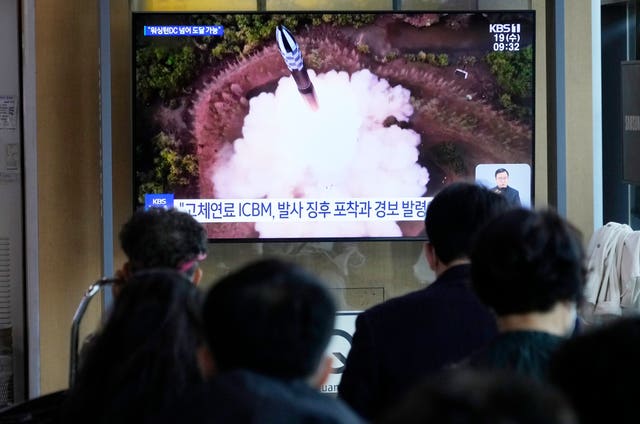US to send nuclear ballistic submarines to Korean Peninsula
The planned dock visits are a key element of what is being dubbed the Washington Declaration.

Presidents Joe Biden and Yoon Suk Yeol will sign an agreement that includes plans to have US nuclear-armed submarines dock in South Korea for the first time in more than 40 years, according to senior Biden administration officials.
The planned dock visits are a key element of what is being dubbed the Washington Declaration, aimed at deterring North Korea from carrying out an attack on its neighbour.
It is being unveiled as Mr Biden is hosting Mr Yoon for a state visit during a moment of heightened anxiety for both leaders over an increased pace of ballistic missile tests by North Korea over the last several months.

The three senior Biden administration officials, who briefed reporters ahead of the announcement, said that Mr Biden’s and Mr Yoon’s aides had been working on details of the plan for months and agreed that “occasional” and “very clear demonstrations of the strength” of US extended deterrence capabilities needed to be an essential aspect of the agreement.
The agreement also calls for the US and South Korean militaries to strengthen joint training and better integrate South Korean military assets into the joint strategic deterrence effort.
As part of the declaration, South Korea will reaffirm its commitment to the Nuclear Non-Proliferation Treaty, an agreement signed by several major nuclear and non-nuclear powers that pledged their co-operation to stem the spread of nuclear technology, the officials said.
As a candidate for the presidency last year, Mr Yoon said he would call for the increased deployment of US bombers, aircraft carriers and nuclear submarines to South Korea as he looked to offer a firmer response to the North’s threats than his predecessor Moon Jae-in.

In the midst of the Cold War in the late 1970s, US nuclear-armed ballistic missile submarines made frequent port visits to South Korea, sometimes two to three visits per month, according to the Federation of American Scientists.
It was a period when the US had hundreds of nuclear warheads located in South Korea.
But in 1991, the United States withdrew all of its nuclear weapons from the Korean Peninsula, and the following year Seoul and Pyongyang signed a joint declaration pledging that neither would “test, manufacture, produce, receive, possess, store, deploy or use nuclear weapons”.
But as the North has repeatedly violated the joint declaration over the years, there has been increased support in South Korea for the United States to return nuclear weapons to the country.

One Biden administration official cautioned it was “crystal clear” that there were no plans by the administration for “returning tactical or any other kind of nuclear weapon to the Korean Peninsula”.
Instead, administration officials said they envisioned the visit of ballistic missile submarines would be followed by the US military more regularly deploying assets such as bombers or aircraft carriers to South Korea.
North Korea’s increasing nuclear threats, along with concerns about China’s military and economic assertiveness in the region, has pushed the Biden administration to expand its Asian alliance.
To this end, Mr Biden has thrown plenty of attention at Mr Yoon as well as Japanese prime minister Fumio Kishida. Next week, the US president will host Philippine president Ferdinand Marcos Jr for talks at the Oval Office.
In the past year, North Korea has been steadily expanding its nuclear arsenal, while China and Russia repeatedly block US-led efforts to toughen sanctions on the North over its barrage of banned missile tests.





